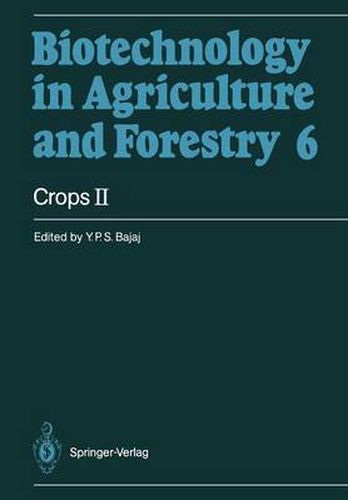Readings Newsletter
Become a Readings Member to make your shopping experience even easier.
Sign in or sign up for free!
You’re not far away from qualifying for FREE standard shipping within Australia
You’ve qualified for FREE standard shipping within Australia
The cart is loading…






This title is printed to order. This book may have been self-published. If so, we cannot guarantee the quality of the content. In the main most books will have gone through the editing process however some may not. We therefore suggest that you be aware of this before ordering this book. If in doubt check either the author or publisher’s details as we are unable to accept any returns unless they are faulty. Please contact us if you have any questions.
The increasing use of biotechnology for the improvement of agricultural crop species has gained momentum, and recent developments (see Crops J) have shown beyond doubt the far-reaching implications of biotechnological approaches for future agricultural research and plant- breeding programs. The production of novel plants and somaclones showing resistance to pests, diseases, herbicides, and salt and the early release of disease-free as well as improved cultivars have become reality. The present volume comprises 31 chapters and deals with the impor- tance, distribution, conventional propagation, micropropagation, and methods for the in-vitro induction of genetic variability in various fruits, vegetables, grasses, and pasture crops such as grapes, strawberry, brambles, red raspberry, currants, gooseberry, kiwifruit, blueberry, cran- berry, cauliflower, cabbage, brussels sprouts, broccoli, cucumber, chico- ry, taro, rhubarb, lettuce, spinach, quinoa, kale, fescue, bromegrass, Ber- mudagrass, napier grass, foxtail millet, turtle grass and others. (The cere- als and other vegetable crops are discussed in Crops J, Vol. 2 of the series). Micropropagation of some fruit crops such as strawberry, grape, and raspberry is already being practiced on a large scale in various countries. Likewise, test-tube-derived plants of certain crops such as brassicas, let- tuce, and taro and improved pastures are being utilized, while the technology for mass propagation of certain other crops is being worked out. These recent developments emphasize the urgent need to arouse awareness among horticultural scientists and plant breeders to enable them to incorporate these modern innovative approaches into routine crop improvement programs.
$9.00 standard shipping within Australia
FREE standard shipping within Australia for orders over $100.00
Express & International shipping calculated at checkout
This title is printed to order. This book may have been self-published. If so, we cannot guarantee the quality of the content. In the main most books will have gone through the editing process however some may not. We therefore suggest that you be aware of this before ordering this book. If in doubt check either the author or publisher’s details as we are unable to accept any returns unless they are faulty. Please contact us if you have any questions.
The increasing use of biotechnology for the improvement of agricultural crop species has gained momentum, and recent developments (see Crops J) have shown beyond doubt the far-reaching implications of biotechnological approaches for future agricultural research and plant- breeding programs. The production of novel plants and somaclones showing resistance to pests, diseases, herbicides, and salt and the early release of disease-free as well as improved cultivars have become reality. The present volume comprises 31 chapters and deals with the impor- tance, distribution, conventional propagation, micropropagation, and methods for the in-vitro induction of genetic variability in various fruits, vegetables, grasses, and pasture crops such as grapes, strawberry, brambles, red raspberry, currants, gooseberry, kiwifruit, blueberry, cran- berry, cauliflower, cabbage, brussels sprouts, broccoli, cucumber, chico- ry, taro, rhubarb, lettuce, spinach, quinoa, kale, fescue, bromegrass, Ber- mudagrass, napier grass, foxtail millet, turtle grass and others. (The cere- als and other vegetable crops are discussed in Crops J, Vol. 2 of the series). Micropropagation of some fruit crops such as strawberry, grape, and raspberry is already being practiced on a large scale in various countries. Likewise, test-tube-derived plants of certain crops such as brassicas, let- tuce, and taro and improved pastures are being utilized, while the technology for mass propagation of certain other crops is being worked out. These recent developments emphasize the urgent need to arouse awareness among horticultural scientists and plant breeders to enable them to incorporate these modern innovative approaches into routine crop improvement programs.